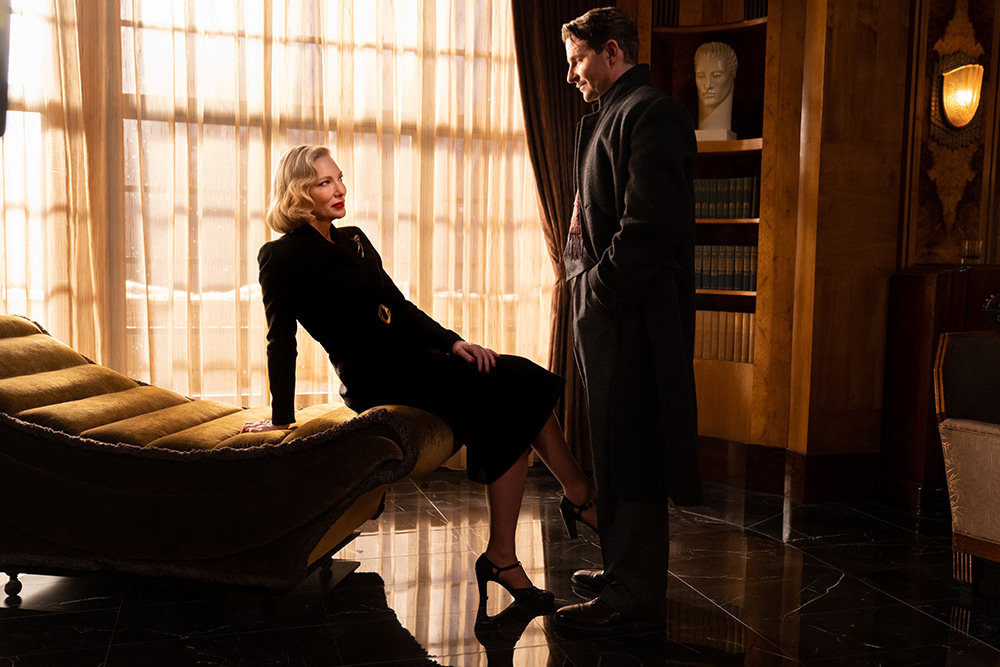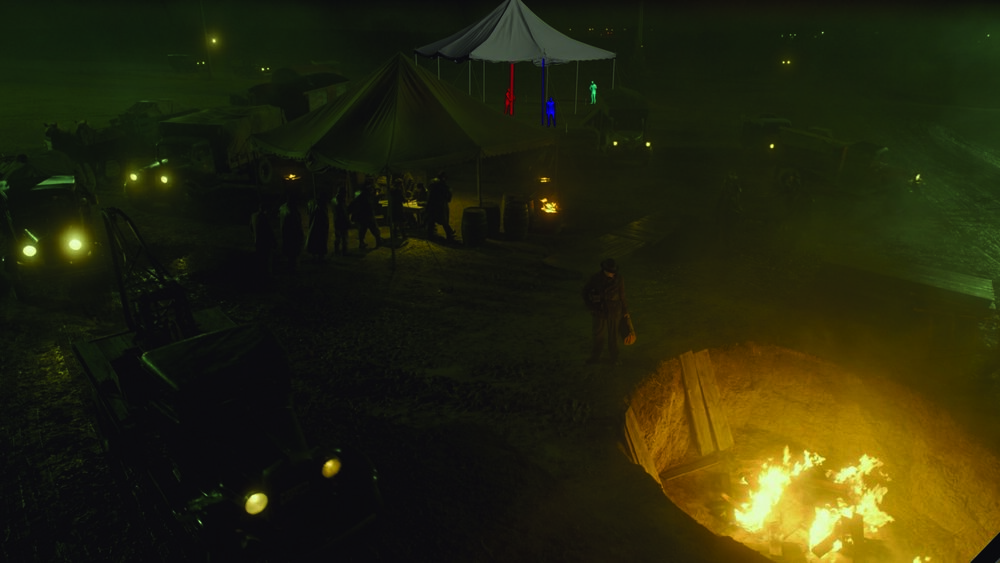***This article was written for the February ’22 issue of Animation Magazine (No. 317)***
[The feature offers a behind-the-scenes look at the movie and contains information that might be considered spoilers by some readers.]
Nightmare Alley is a departure of sorts for fantasy-horror master Guillermo del Toro (The Shape of Water), as the crime noir based on William Lindsay Gresham’s 1946 novel explores the physical and psychological brutality that human beings inflict on each other. The Gothic atmosphere is not entirely absent as grifter-turned-psychic Stanton Carlisle (Bradley Cooper) rises from a carnival freak show and enters the even darker realm of high society.
Overseeing the 900 visual effects shots of the film was frequent collaborator Dennis Berardi (Crimson Peak), who worked Mr. X and Legacy FX to create a bodysuit with a massive scar, pickled punks (fluid-preserved specimens) and a shot-off ear for the big-budget project.
Strangely enough, some of the film’s hardest shots were the ones involving the chicken which gets eaten by the carnival geek. “Guillermo is hypersensitive to creatures, things looking real and performances,” notes Berardi. “Developing the animation, the muscle and feather system, and the blood simulation for the spurting — those were the areas where we did a lot of R&D. It was a big rendering show because we had so much volume.”

Delivering Digital Snow (and Chickens)
Berardi says they rendered 15,000 versions internally of shots (del Toro didn’t see all of those), used a total of 450 terabytes of data and had 929,000 of CPU render hours, which translated into 38,300 render days. “Guillermo’s process is exploratory, so we tried different takes to find looks, especially for the snow simulation, blood work and even animation on the chicken, vehicles and digital doubles,” explains the VFX supe. “Guillermo reinvents himself every time. He’s not making another The Shape of Water. Nightmare Alley is an entirely different adventure.”
Even with a significant number of nighttime scenes, there is an extensive amount of photographic detail. “[Cinematographer] Dan Laustsen [Headhunter] sculpted the light and the falloff was by design, but there is no falloff in the middle ground, which is where most of my work lives,” Berardi points out. “I decided to rely on rotoscoping rather than use bluescreen or greenscreen, especially for the carnival which was going to be windy on that set. We had to move quickly and then there was the issue of COVID-19. When Stan gets on the bus in the beginning and there is a time-lapse shot where he arrives at the carnival, that was captured against greyscreen, because of all of those reflective surfaces. There was a fair amount of talk about the color temperature of the lights. We were careful to match into Dan’s color imagery. It wasn’t as simple as making everything tungsten, because the look is far more complex than that.”

Production designer Tamara Deverell (The Strain) designed and built a carnival that was digitally extended for wide shots. “It was an amazing set,” notes Berardi. “We added digital people and period vehicles, made the Ferris wheel move, replaced a lot of the skies and did lightning and did a fair amount of signage, including the ‘Bath 10 cents’ sign outside of Zeena’s [Toni Collette] bungalow. Neon signs are tricky to render and composite right, because they’re either too saturated or not saturated enough.”
Electrical discharges were incorporated into the carnival performance of Molly Cahill (Rooney Mara), who is supposed to be a human conduit. “We had a 3D model of Molly, match-moved her performance, and electrical arcs could be emitted anywhere we wanted. The whole set was scanned, and Guillermo carefully art directed where he wanted the arcs.”
Fire is a prominent visual element throughout the movie. “For the opening scene, Guillermo wanted more fire and smoke, so we did some digitally to go alongside the practical, and the embers that you see are also visual effects,” remarks Berardi. “That was a nice collaboration. In terms of the fire going in reverse, that was a stylistic choice made by Guillermo in post, so we ended up removing a lot of the fire that was there because the retiming was causing the practical fire to do some crazy things.”
The movie also features many shots of snow-covered city landscapes (filmed in Buffalo, New York). “We scanned every exterior location and had proxy geometry for Ezra Grindle’s [Richard Jenkins] mansion and back garden,” recalls Berardi. “Guillermo wanted snow swirling off of the hedge tops, so we were able to match-move our geometry over the actual photographed plate and then emit snow from the top of those hedges, and have snow fall and perform. We would add gravity, turbulence and a counterwind to make it look interesting. We tried to respect Dan’s lighting by mostly backlighting the snow, which is what he did onset. There was a lot of rotoscoping to get snow in front and behind the actors in the close-up shots.”



It was important that the blood and gore did not upstage the themes and quieter moments in Nightmare Alley. “There was a version when Mrs. Kimball [Mary Steenburgen] kills Judge Kimball [Peter MacNeill] and then herself which was gorier, but Guillermo decided to tone that down,” explains Berardi. “However, when Stan bashes in the face of Grindle, he wanted it to be very violent. The death of Anderson [Holt McCallany] is somewhat gory in that we rip off the top of his head. Guillermo wanted that to represent the downward spiral Stan is in at that point, so gore was appropriate there. He calibrated us in terms of where we needed to be depending on the scene.”
Another big VFX task was creating Enoch, the abnormal human baby with a large eye kept in the specimen jar in the carnival. As Berardi notes, “Legacy FX physically built Enoch and we scanned it. The reason for why we did a digital version is because Guillermo wanted to have an impossible macro camera move for the title sequence.”
“If you want to watch out for something that is fun, maybe look at Grindle’s death where Stun punches him repeatedly and he lands on the ground — that’s a digital face,” reveals Berardi. “We had the actor play-act that he was dead. We then replaced a portion of his face and had all of this negative space in his nose right down to the skeletal structure and put digital blood pumping through his nose.”

Beautiful in Black and White
In true cinephile fashion, del Toro pays homage to the original 1947 adaptation directed by Edmund Goulding and starring Tyrone Power. “The black and white version of the movie will also be released on a limited basis. If we do our job right as visual effects artists, we match into the original photography, color space, color imagery and resolution so when they convert the film from color to black and white [during the DI process] our stuff will go along for the ride and be seamless.”
The scope of the digital augmentation is deceiving. “Almost every scene had some level of visual effects work on it,” states Berardi. “There were 900 visual effects shots at 4K. The biggest challenge was being invisible with this level of scope.”
There are also invisible effects at work during a pivotal lie detector test. “We had a great prop but it wasn’t going to work with the scene-specific drama that Guillermo was cutting. The needles were animated, and we did the paper and ink coming out. We added a ‘truth or lie’ light as well to exactly perform the way that Guillermo wanted it to. The top of the lie detector was replaced. We wanted the actors and the drama to drive the scene, rather than a prop that it is difficult to manage onset. The lie detector is beautifully invisible!”
“The whole point of this film is for you to have an immersive experience,” Berardi concludes. “We want to put you into this 1940s noir world and I hope that the exterior shots help to establish this world.”
Nightmare Alley is now screening in North American theaters through Searchlight Pictures. The film will have its European rollout in January.





 Win a Funko X Lilo & Stitch Prize Pack!
Win a Funko X Lilo & Stitch Prize Pack! 
